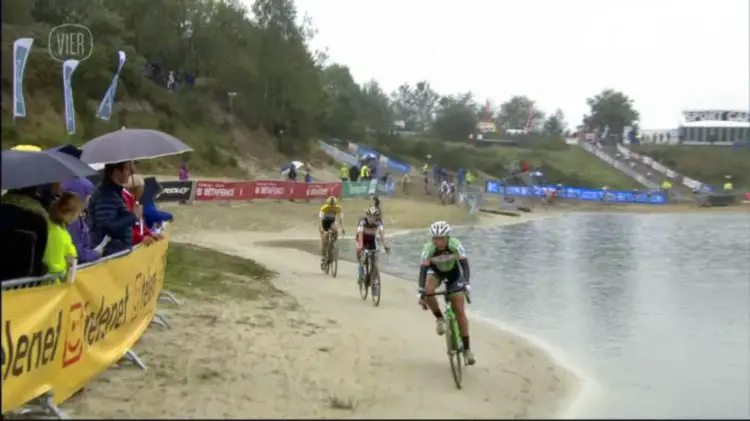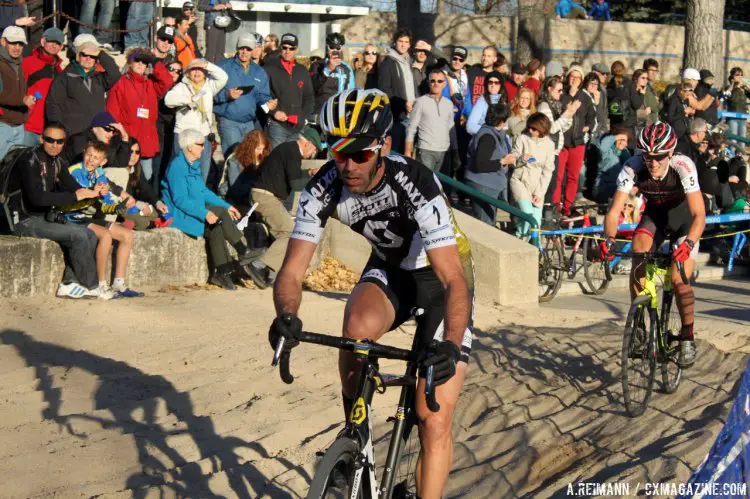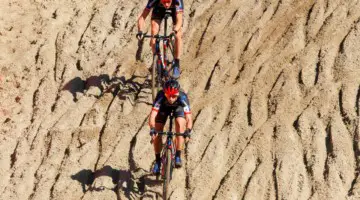With Cycle-Smart International coming this weekend (and giving some hints on social media about a possible sand pit) and all the bucket loads of sand in Winnipeg last weekend, now might be the perfect opportunity to refresh the skills of riding through the sand.
Riding through the sand takes some practice to be sure, which is unfortunate since most of us don’t have a natural sand beach in our back yard and many local parks are not exactly keen on us ripping through their volleyball courts on our cyclocross bikes.
Suffice it to say, treating sand like cement, and keeping your weight towards the front wheel at high speeds, can have some disastrous consequences, such as the riders in the video we shared several years back:
Keeping your weight back at all times, particularly during a high speed entry, is key. If you find yourself consistently distributing your weight on the cyclocross bike as you do on your road bike, consider raising your hoods. This might be frowned upon in some circles, but if raising hoods is good enough for Ryan Trebon when riding through the deep mud of the Cross Crusade, it is likely good enough for us too.

Ryan Trebon, tall in stature, is able to keep his weight back with the help of elevated hoods. © Pat Malach
But weight distribution is hardly the only element that will help riders dominate the sand. Picking your lines upon entry is key, and riding the ruts that riders already made before your race is a sure way to increase speed.
Unlike riding on the grass, where the early races of the day usually burn in bad lines, following the “worst” of lines in the sand is far superior to attempting to dig through fresh sand. Inevitably, you’ll get the opportunity in a race to pass a line of riders through the sand by riding on the path less traveled. Although this is attractive upon entering the pit, you will soon realize how much more effort it took to ride through the course for one or two spots, if any.

Elite riders in Europe are often seen contouring their bodies above their bikes for balance, and often riding in single or double file for the best lines. © Bart Hazen
The last tip is perhaps the trickiest of them all for unpracticed riders: letting the front wheel choose its own path.
Even pro-level riders can’t stick to the ruts in the sand on every lap, most even have a hard time traversing one for the full length of a sandpit. Because your front wheel will be crossing multiple lines, and sometimes fresh sand, riders have to remember to keep their weight back at all times and resist the urge to fight against movement in the front wheel. Trying to force a line with a tense grip on your handlebars is a quick way to stick your front wheel and see you careen over your handlebars.

There was plenty of sand in the 2014 Superprestige Gieten women’s race, although wet sand is far less difficult to ride over – vier.be video screenshot
Sven Nys is notorious for recommending a big gear through mud, and although sand can be more tacky than full on greasy mud, a similar principle can be applied. Anticipating sand by shifting to the lowest gear can have the unintended consequence of spinning a rear wheel, which kicks up sand rather than propels the rider forward. On the other hand, a rider that picks to hard of a gear will find themselves unable to keep churning away.
Ideally speaking, smooth, strong pedal strokes in a moderately big gear is one of the best ways to keep a rider from stalling in the middle of the sand and force a dismount.
To see some of these concepts in action, check out the video from the folks at Global Cycling Network, who have created a great three-minute tutorial on riding through sand:





























